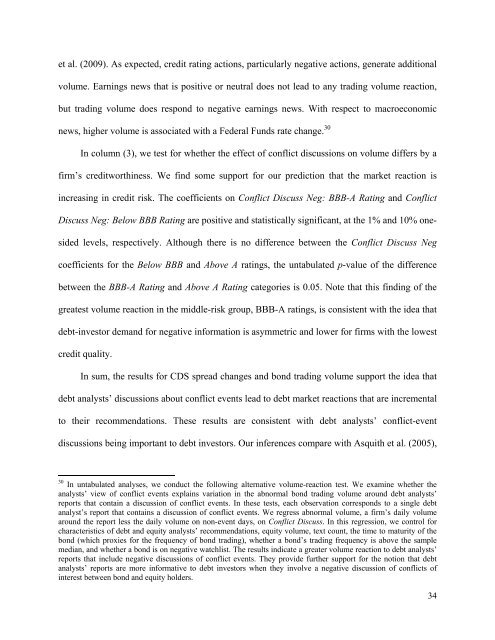Debt Analysts' Views of Debt-Equity Conflicts of Interest
Debt Analysts' Views of Debt-Equity Conflicts of Interest
Debt Analysts' Views of Debt-Equity Conflicts of Interest
Create successful ePaper yourself
Turn your PDF publications into a flip-book with our unique Google optimized e-Paper software.
et al. (2009). As expected, credit rating actions, particularly negative actions, generate additional<br />
volume. Earnings news that is positive or neutral does not lead to any trading volume reaction,<br />
but trading volume does respond to negative earnings news. With respect to macroeconomic<br />
news, higher volume is associated with a Federal Funds rate change. 30<br />
In column (3), we test for whether the effect <strong>of</strong> conflict discussions on volume differs by a<br />
firm’s creditworthiness. We find some support for our prediction that the market reaction is<br />
increasing in credit risk. The coefficients on Conflict Discuss Neg: BBB-A Rating and Conflict<br />
Discuss Neg: Below BBB Rating are positive and statistically significant, at the 1% and 10% one-<br />
sided levels, respectively. Although there is no difference between the Conflict Discuss Neg<br />
coefficients for the Below BBB and Above A ratings, the untabulated p-value <strong>of</strong> the difference<br />
between the BBB-A Rating and Above A Rating categories is 0.05. Note that this finding <strong>of</strong> the<br />
greatest volume reaction in the middle-risk group, BBB-A ratings, is consistent with the idea that<br />
debt-investor demand for negative information is asymmetric and lower for firms with the lowest<br />
credit quality.<br />
In sum, the results for CDS spread changes and bond trading volume support the idea that<br />
debt analysts’ discussions about conflict events lead to debt market reactions that are incremental<br />
to their recommendations. These results are consistent with debt analysts’ conflict-event<br />
discussions being important to debt investors. Our inferences compare with Asquith et al. (2005),<br />
30 In untabulated analyses, we conduct the following alternative volume-reaction test. We examine whether the<br />
analysts’ view <strong>of</strong> conflict events explains variation in the abnormal bond trading volume around debt analysts’<br />
reports that contain a discussion <strong>of</strong> conflict events. In these tests, each observation corresponds to a single debt<br />
analyst’s report that contains a discussion <strong>of</strong> conflict events. We regress abnormal volume, a firm’s daily volume<br />
around the report less the daily volume on non-event days, on Conflict Discuss. In this regression, we control for<br />
characteristics <strong>of</strong> debt and equity analysts’ recommendations, equity volume, text count, the time to maturity <strong>of</strong> the<br />
bond (which proxies for the frequency <strong>of</strong> bond trading), whether a bond’s trading frequency is above the sample<br />
median, and whether a bond is on negative watchlist. The results indicate a greater volume reaction to debt analysts’<br />
reports that include negative discussions <strong>of</strong> conflict events. They provide further support for the notion that debt<br />
analysts’ reports are more informative to debt investors when they involve a negative discussion <strong>of</strong> conflicts <strong>of</strong><br />
interest between bond and equity holders.<br />
34
















